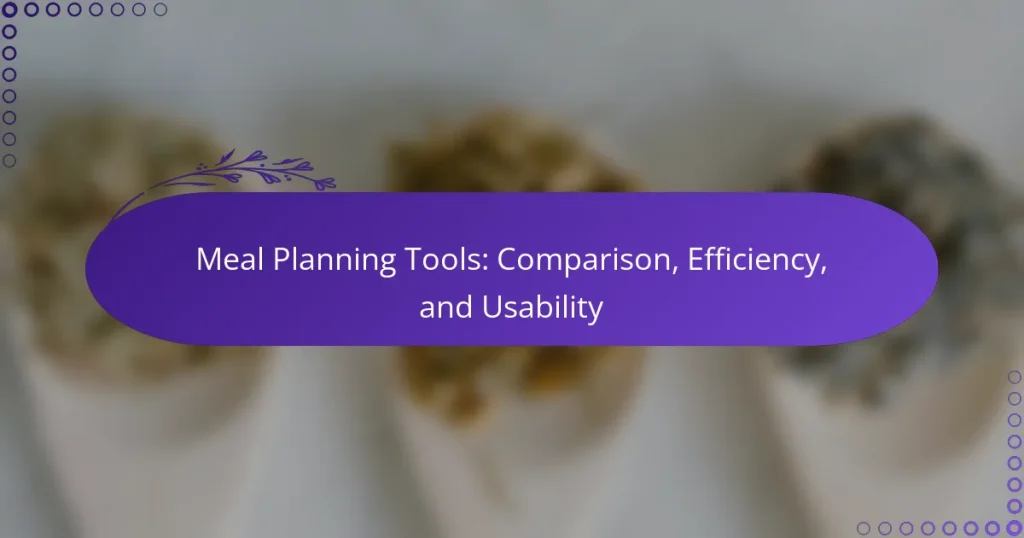Meal planning tools are designed to simplify the organization of meals, shopping lists, and recipes, ultimately promoting a healthier lifestyle. With various options like Mealime, Plan to Eat, and Paprika, each tool offers distinct features tailored to different user preferences and needs. By enhancing efficiency and reducing stress, these tools allow individuals to concentrate on cooking rather than the complexities of meal preparation.
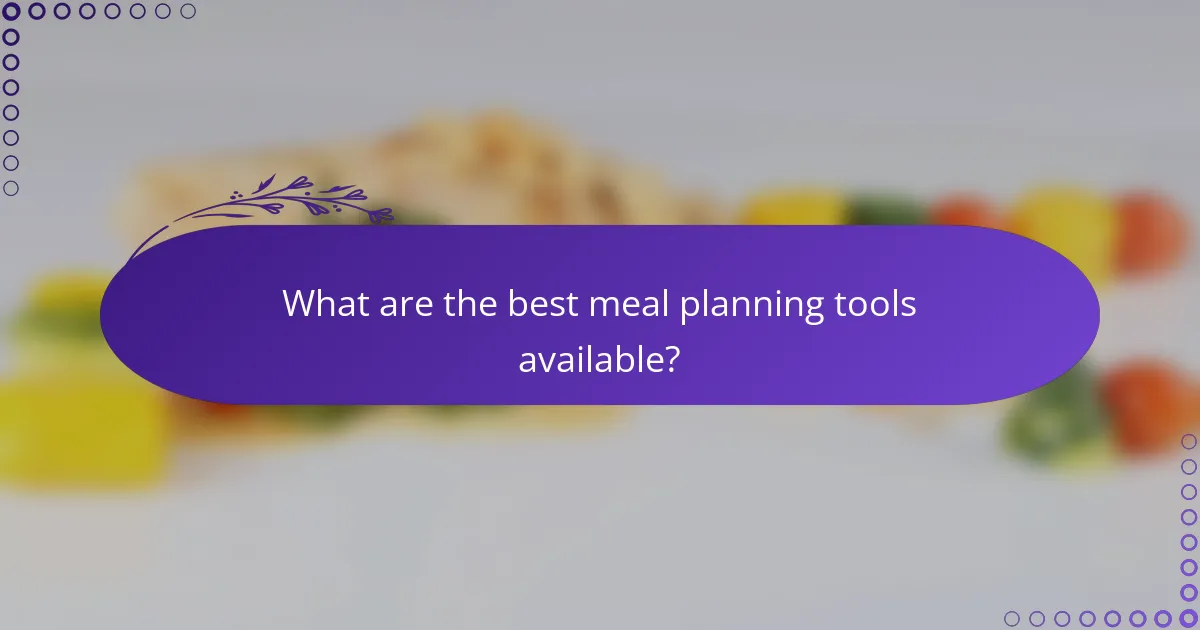
What are the best meal planning tools available?
The best meal planning tools streamline the process of organizing meals, shopping lists, and recipes, making it easier to maintain a healthy diet. Popular options include Mealime, Plan to Eat, Paprika, Yummly, and Eat This Much, each offering unique features and usability for different needs.
Mealime
Mealime is designed for simplicity and efficiency, allowing users to create meal plans based on dietary preferences and restrictions. It offers a user-friendly interface where you can select recipes and automatically generate shopping lists.
One of its standout features is the ability to customize serving sizes, which is helpful for families or meal prepping. Mealime also provides nutritional information, making it easier to track your intake.
Plan to Eat
Plan to Eat focuses on integrating recipes and meal planning into a cohesive system. Users can import recipes from various websites and organize them into a calendar for meal planning.
This tool allows for easy adjustments to serving sizes and generates shopping lists based on your planned meals. A subscription fee applies, but many find the comprehensive features worth the investment.
Paprika
Paprika is a versatile app that combines recipe management with meal planning and grocery list creation. Users can save recipes from the web, categorize them, and plan meals efficiently.
It also offers a built-in timer and a pantry feature to track ingredients on hand. Paprika is a one-time purchase app, making it a cost-effective choice for those who prefer not to pay ongoing fees.
Yummly
Yummly excels in personalized recipe recommendations based on user preferences and dietary needs. The app provides a vast database of recipes and allows for meal planning and grocery list generation.
Yummly’s smart shopping list feature categorizes items by store sections, enhancing shopping efficiency. The app is free, but premium features are available for a subscription fee.
Eat This Much
Eat This Much is designed for those who want automated meal planning based on calorie goals and dietary preferences. Users input their goals, and the tool generates meal plans that meet those criteria.
This tool is particularly useful for fitness enthusiasts and those looking to lose weight. A subscription is required for full access, but the automated planning can save significant time and effort in meal prep.
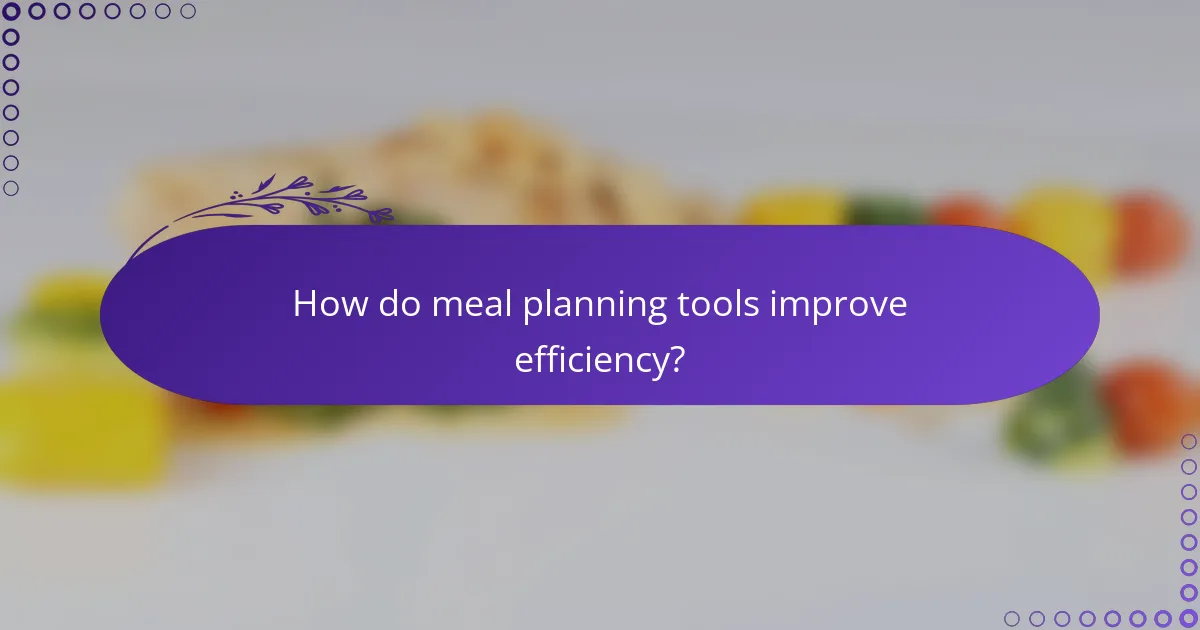
How do meal planning tools improve efficiency?
Meal planning tools enhance efficiency by streamlining the process of organizing meals, shopping for ingredients, and managing recipes. They save time and reduce stress, allowing users to focus on cooking rather than planning.
Time-saving features
Many meal planning tools include features like drag-and-drop meal scheduling and customizable templates that allow users to quickly create meal plans. These tools can often generate plans based on dietary preferences or restrictions, which saves considerable time in decision-making.
Additionally, some platforms offer pre-set meal plans that cater to various dietary needs, such as vegetarian or gluten-free. This can further reduce the time spent on planning meals, making it easier to stick to a healthy eating routine.
Automated grocery lists
Automated grocery lists are a key feature of meal planning tools, allowing users to generate shopping lists based on their meal plans with a single click. This eliminates the need to manually compile ingredients, saving time and reducing the likelihood of forgetting items.
Some tools even categorize grocery items by store sections, making shopping more efficient. Users can also adjust quantities based on their household size, ensuring they purchase the right amount of food without waste.
Recipe organization
Recipe organization features help users keep track of their favorite recipes in one place, making it easy to access and utilize them when planning meals. Many tools allow users to tag recipes by cuisine, dietary restrictions, or preparation time, facilitating quicker meal selection.
Furthermore, some meal planning tools enable users to import recipes from websites or share their own, creating a personalized recipe library. This organization not only saves time but also encourages culinary exploration and variety in meal choices.

What factors should you consider when choosing a meal planning tool?
When selecting a meal planning tool, consider usability, integration capabilities, and cost. These factors will significantly impact your overall experience and efficiency in meal preparation.
User interface
A user-friendly interface is crucial for a meal planning tool. Look for intuitive navigation, clear visuals, and easy access to features. Tools that offer drag-and-drop functionality or customizable templates can enhance your planning experience.
Consider whether the tool is available on multiple devices, such as smartphones and tablets. This flexibility allows you to plan meals on the go or while shopping, making it more convenient.
Integration with grocery delivery services
Integration with grocery delivery services can streamline your meal planning process. Tools that connect directly with platforms like Instacart or Amazon Fresh enable you to order ingredients with a few clicks, saving time and effort.
Check if the meal planning tool automatically generates shopping lists based on your selected recipes. This feature can help ensure you don’t miss any ingredients and can simplify the grocery shopping experience.
Cost and subscription options
Evaluate the cost of meal planning tools, as prices can vary widely. Some tools offer free basic versions with limited features, while others may charge monthly or annual fees ranging from low single digits to higher amounts depending on the features provided.
Look for tools that offer a free trial or a money-back guarantee. This allows you to test the functionality and see if it meets your needs before committing to a subscription.

How do meal planning tools compare in usability?
Meal planning tools vary significantly in usability, impacting how easily users can create and manage their meal plans. Key factors include mobile app accessibility, customization options, and user reviews, all of which contribute to the overall experience.
Mobile app accessibility
Mobile app accessibility is crucial for meal planning tools, as many users prefer to plan meals on-the-go. Most popular tools offer dedicated mobile applications that are compatible with both iOS and Android devices, allowing users to access their plans anytime, anywhere.
When evaluating accessibility, consider the app’s interface and ease of navigation. A user-friendly design can significantly enhance the experience, while a cluttered layout may lead to frustration. Look for apps that provide offline access, which can be beneficial when internet connectivity is limited.
Customization options
Customization options play a vital role in the effectiveness of meal planning tools. Users should look for features that allow them to tailor meal plans according to dietary preferences, portion sizes, and specific nutritional goals. This flexibility can help accommodate various lifestyles, including vegetarian, vegan, or gluten-free diets.
Some tools offer advanced customization, such as the ability to input personal recipes or adjust serving sizes easily. A good meal planning tool should allow users to save their favorite meals and create rotating menus to simplify the planning process.
User reviews and ratings
User reviews and ratings provide valuable insights into the usability of meal planning tools. Checking app stores or dedicated review sites can help identify which tools are favored by users and which ones have consistent issues. Look for tools with high ratings and positive feedback regarding ease of use and functionality.
Pay attention to common themes in reviews, such as the app’s performance, customer support, and any recurring bugs. Tools that frequently receive updates and improvements based on user feedback tend to offer a better long-term experience.
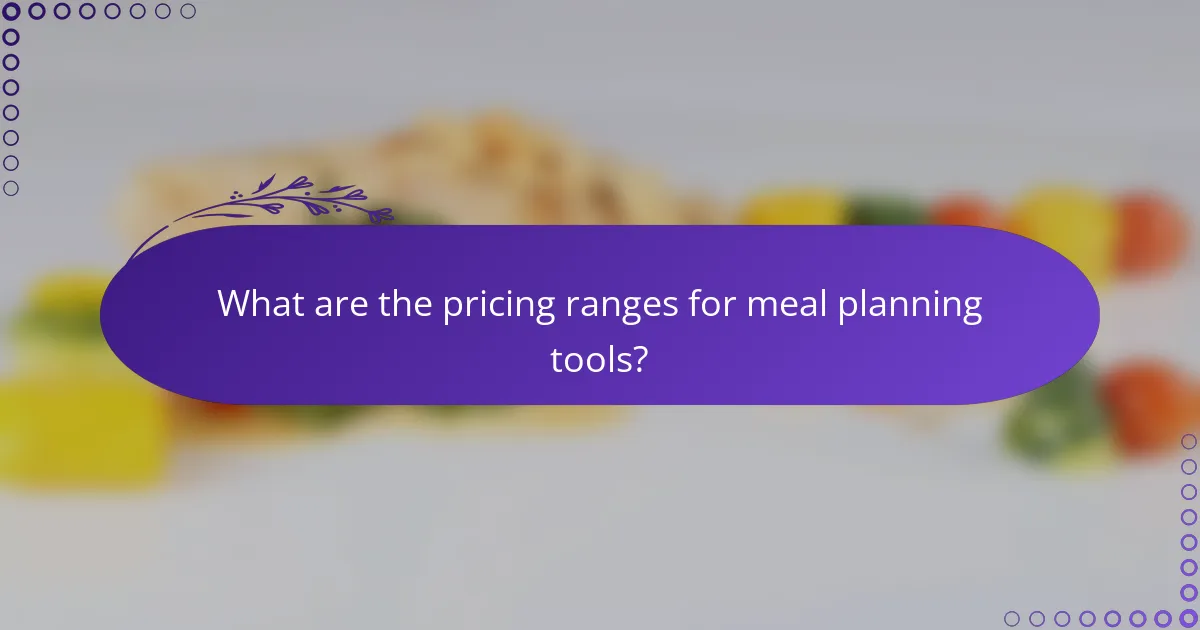
What are the pricing ranges for meal planning tools?
Meal planning tools can vary significantly in price, with options available for free, monthly subscriptions, or one-time purchases. Understanding these pricing ranges helps users choose a tool that fits their budget and needs.
Free vs. paid options
Free meal planning tools often provide basic features, such as simple recipe storage and meal scheduling. While these can be effective for casual users, they may lack advanced functionalities like nutritional analysis or grocery list integration.
Paid options typically offer a broader range of features, including customizable meal plans, shopping lists, and access to a larger recipe database. Users should consider their meal planning frequency and needs when deciding whether a free tool suffices or if a paid option is warranted.
Monthly subscription costs
Monthly subscription costs for meal planning tools generally range from around $5 to $20 per month. This pricing often reflects the level of features and support provided, with higher tiers offering more comprehensive services.
When evaluating monthly subscriptions, consider any trial periods or discounts for longer commitments. Some platforms may offer family plans that can reduce the cost per user, making them more economical for households.
Lifetime purchase options
Lifetime purchase options for meal planning tools can range from approximately $30 to $200. This one-time fee typically grants users access to all features without ongoing costs.
While a lifetime purchase can be cost-effective in the long run, users should ensure the tool meets their needs and offers regular updates. It’s also wise to check the company’s reputation for customer support and software longevity before making a commitment.
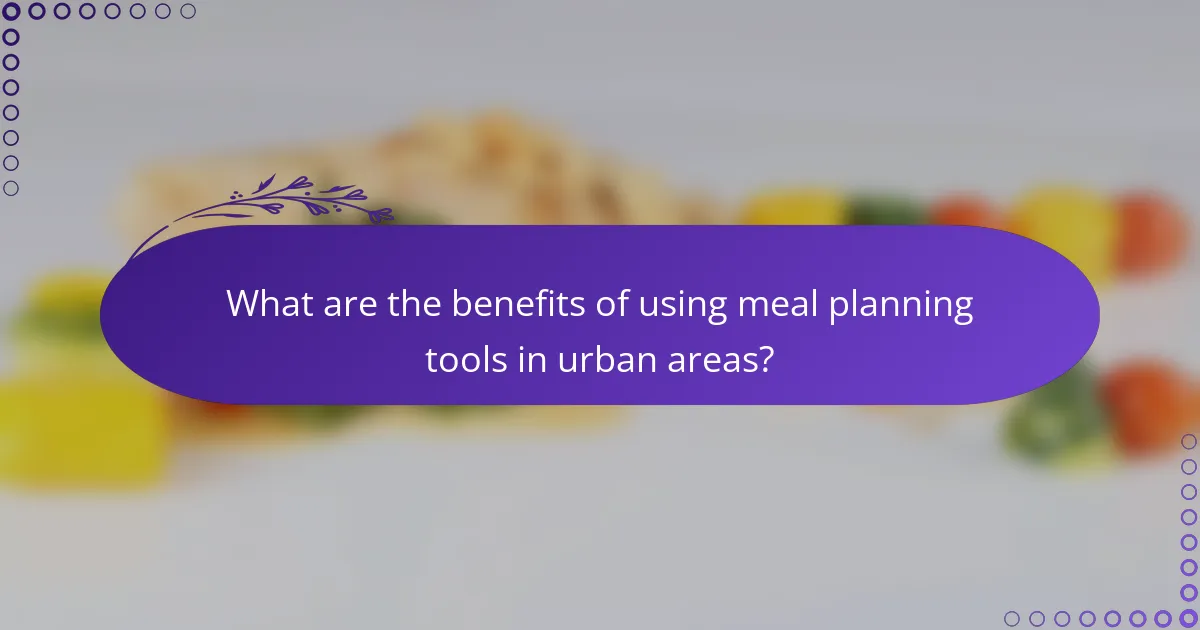
What are the benefits of using meal planning tools in urban areas?
Meal planning tools offer urban dwellers a way to save time and money while promoting healthier eating habits. These tools help streamline grocery shopping, reduce food waste, and make it easier to prepare balanced meals amidst a busy lifestyle.
Efficiency in grocery shopping
Using meal planning tools can significantly enhance efficiency in grocery shopping. By generating shopping lists based on planned meals, these tools minimize the time spent wandering aisles and reduce impulse purchases. Many apps allow users to categorize items by store sections, further speeding up the shopping process.
Urban residents often face crowded stores and limited time, making efficient shopping crucial. A well-organized shopping list can save not just time but also money, as it helps avoid buying unnecessary items and promotes bulk purchasing of staple ingredients.
Reducing food waste
Meal planning tools play a vital role in reducing food waste, which is especially important in urban areas where space is limited. By planning meals in advance, users can purchase only the ingredients they need, leading to less spoilage and waste. This not only benefits the environment but also saves money.
For example, if a family plans meals for the week, they can ensure that all purchased items are used before their expiration dates. Some apps even track expiration dates and suggest recipes based on ingredients that need to be used soon.
Promoting healthier eating habits
Meal planning tools encourage healthier eating by making it easier to incorporate a variety of foods into daily meals. Users can plan balanced meals that include fruits, vegetables, proteins, and whole grains, which can be challenging in fast-paced urban environments.
Additionally, many meal planning apps offer nutritional information and suggest healthier alternatives to common ingredients. This guidance can help users make informed choices and develop better eating habits over time.
